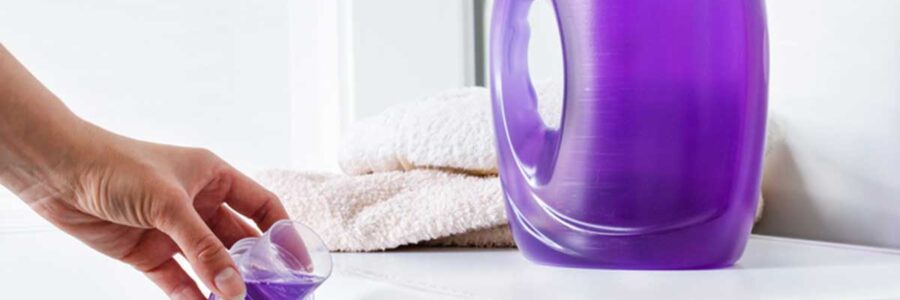Fabric softeners, used during the laundry process, serve multiple purposes. They reduce static cling, soften the texture of our clothes, and give our laundry a fresh, pleasing fragrance. Available in various forms, such as liquids, beads, and dryer sheets, these products contain ingredients like conditioning agents, emulsifiers, and fragrances.[2]
The Popularity and Misconceptions of Fabric Softeners
Over the years, fabric softeners have become a standard part of many laundry routines. Thanks to their ability to make clothes feel softer and smell better, they’re seen as an easy and effective way to enhance the quality of our laundry. However, their increased use raises questions about what we’re introducing into our homes and pouring into our environment. There’s a common misconception that fabric softeners only bring benefits, like improving the feel of clothes and providing a fresh scent. In reality, their effects extend beyond the surface. They can leave behind a residue on our clothes that might be harmful with prolonged contact. Moreover, they can also affect the durability of certain fabrics.[3]
Unveiling the Hidden Dangers of Fabric Softeners
One of the primary concerns about fabric softeners is their chemical composition. Many contain harmful substances such as benzyl acetate, alpha-terpineol, and others, often used for their potent fragrances.[3] These chemicals, while making our clothes smell good, could harm our health. For instance, benzyl acetate can irritate the lungs and potentially harm the respiratory tract.[4] On the other hand, Alpha-terpineol is known to cause dizziness, headaches, and even neurological damage with prolonged exposure.[5]
Environmental Impact of Fabric Softeners
Fabric softeners can also be damaging to our environment. These products often contain synthetic, non-biodegradable compounds that enter our water systems after being washed down the drain. This pollution can harm aquatic life and disrupt ecosystems.[6] Furthermore, the production process for these synthetic chemicals is energy-intensive and contributes to air and water pollution, adding to the environmental burden.[7]
The Need for Safety in Laundry Care
Given the risks outlined, it’s important to be mindful of safety in our laundry routines. The products we use have a direct impact on our health and the health of our environment. Understanding the dangers of fabric softeners and other laundry products is key to making informed, responsible decisions. While individual consumer actions are important, broader change must also occur at the manufacturing and regulatory levels. Manufacturers should prioritize the use of safe, sustainable ingredients in their products. Moreover, regulatory bodies must establish and enforce stringent standards to protect consumers and the environment. Unfortunately, existing ‘trade secret’ laws can make it difficult for consumers to fully know what’s in the products they’re using.[8]
Proactive Consumer Decisions for Health and Sustainability
As consumers, we can exert considerable influence over product safety. We can encourage broader industry changes by choosing to support companies that prioritize health and sustainability. Moreover, we can protect our health and contribute to environmental preservation by opting for safer, natural alternatives.
Exploring Natural Alternatives to Fabric Softeners
Natural alternatives to fabric softeners can provide the benefits we want—soft, static-free, fresh-smelling clothes—without the potential health risks or environmental damage. These alternatives are often safer, more sustainable, and sometimes even more cost-effective than traditional fabric softeners. Examples of natural alternatives include vinegar, wool dryer balls, and baking soda.
References:
- Steinemann, Anne C. “Volatile Emissions from Common Consumer Products.” Air Quality, Atmosphere & Health, vol. 8, no. 3, 2015, pp. 273-281.
- “Fabric Softener.” Encyclopedia.com,www.encyclopedia.com/manufacturing/news-wires-white-papers-and-books/fabric-softener. Accessed 25 July 2023.
- “Why Fabric Softener Is Bad for Your Laundry.” Consumer Reports,www.consumerreports.org/appliances/laundry/why-fabric-softener-is-bad-for-your-laundry-a5931009251/. Accessed 25 July 2023.
- “Benzyl Acetate.” PubChem, National Center for Biotechnology Information, pubchem.ncbi.nlm.nih.gov/compound/Benzyl-acetate. Accessed 25 July 2023.
- “Benzyl Acetate.” Santa Cruz Biotechnology, datasheets.scbt.com/sc-291877.pdf. Accessed 25 July 2023.
- “Skip the Most Toxic Fabric Softeners.” Environmental Working Group,www.ewg.org/news-insights/news/2022/08/skip-most-toxic-fabric-softeners. Accessed 25 July 2023.
- Gaylarde, Christine, et al. “Plastic Microfibre Pollution: How Important is Clothes’ Laundering?” Heliyon, vol. 7, no. 5, 2021, e07105, doi:10.1016/j.heliyon.2021.e07105.
- “Trade Secrets.” World Intellectual Property Organization,www.wipo.int/tradesecrets/en/. Accessed 25 July 2023.


